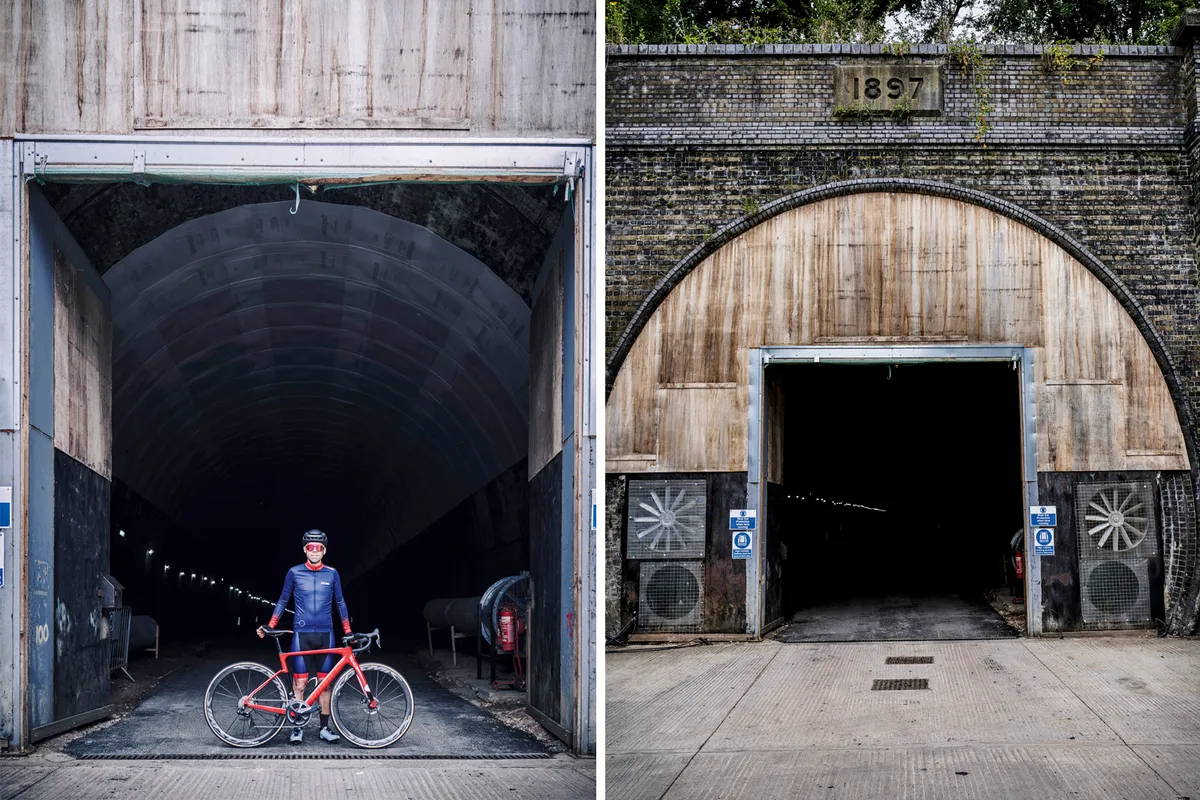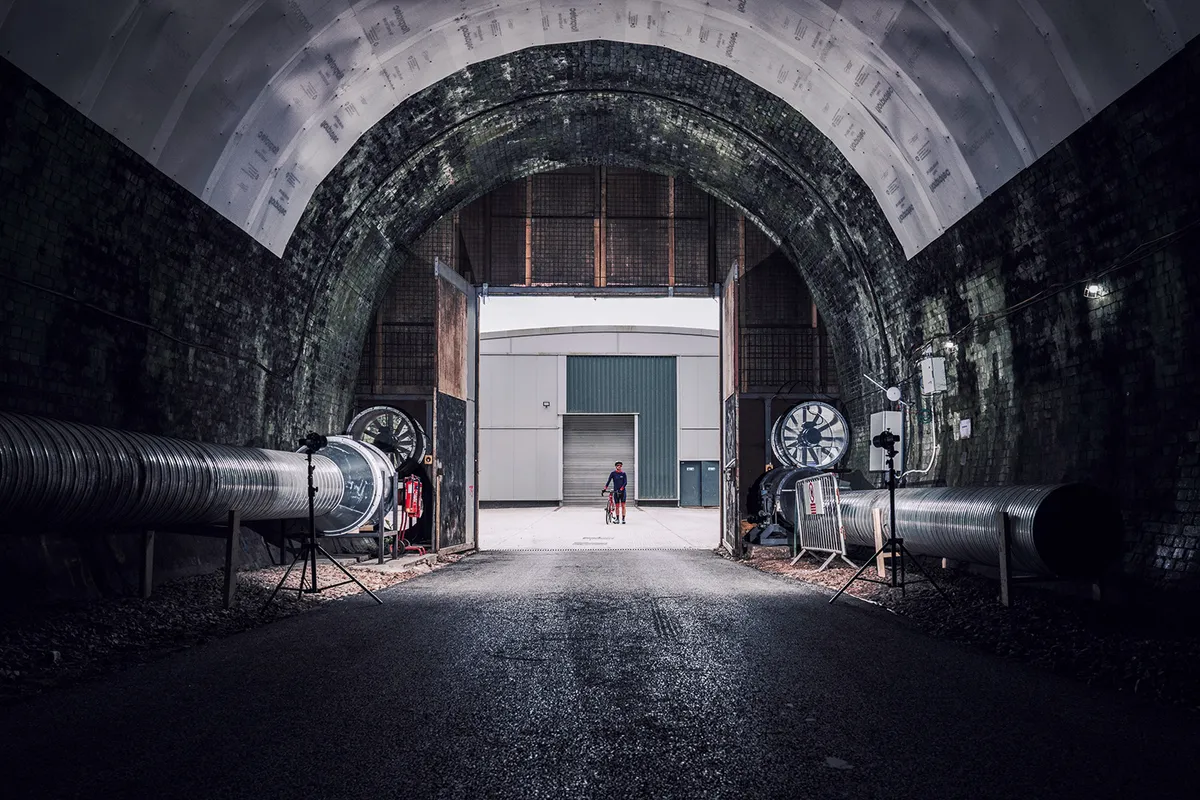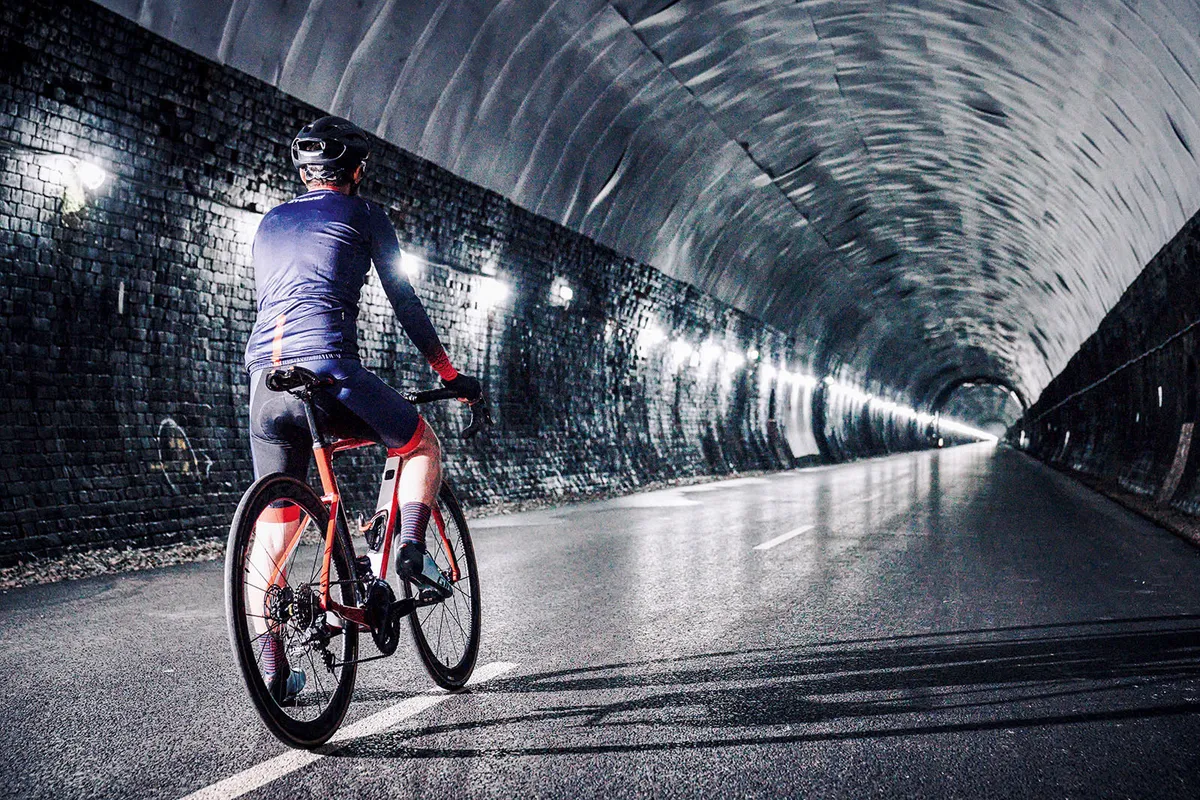“Ladies and gentlemen, welcome to one of the most cutting-edge aerodynamic facilities in the world.”
That’s Brian Scott, tunnel operations manager at Catesby Tunnel in Northamptonshire, once an integral section of the Great Central Main Line from Sheffield to London, now a state-of-the-art testing facility for cyclists, cycling manufacturers and automobiles that opened in December 2021.
Scott says that as far as he's aware, the only facility similar to Catesby is Laurel Hill in Philadelphia, which is used for NASCAR testing.
Scott says Laurel Hill is impressive but the facility is only a mile long, whereas Catesby measures 2.7km in length.
You might expect Catesby to look like a state-of-the-art wind tunnel. However, its eight-metre high doors open to reveal no aerodynamic sensors, no 3D cameras, no measurement tools of any kind…
A blank canvas

“The first thing to say is that we provide standardisation for cyclists and drivers; they provide the diagnostics.
"This is more a barometric chamber than a wind tunnel as, when the doors are closed, the temperature is 10.2°C and humidity 90 per cent. That’s winter and summer,” says Scott.
In other words, it’s a blank canvas for aerodynamicists and sports scientists to paint their bespoke drag-reducing masterpieces by bringing along their aerodynamic sensors, power meters and any other diagnostic tools they possess.
This facility’s USP derives from turning the static, consistent conditions of a wind tunnel into more real-world conditions. To that end, the 2.7km-long stretch of tarmac was laid in one go atop a Victorian culvert to reduce the chances of any bumps and distortions.
There’s an imperceptible rise in gradient of 1:176 and it’s 8.2m wide, which is big enough to deliver one of the key cycling benefits.

“Individuals can find out their most aerodynamic position and best clothing, but we can also accommodate teams in here, which you can’t do in a [wind] tunnel,” says Scott.
“So when it comes to team pursuit, you can find out if it’s better to have a small guy at the front or a big guy. What’s the best shape of formation? In a peloton, which of your riders is pulling or hanging on?”
The positional questions you could answer are endless and it's why WorldTour teams have already been sniffing around. “Especially one,” beams Scott. He remains tight-lipped over which team, though we can speculate with a degree of confidence that it’s Ineos Grenadiers.
Aero wizard Dan Bigham joined the British team in the off-season as a performance engineer. Bigham broke the British hour record in Grenchen last year wearing a customised skinsuit from Vorteq, who are owned by TotalSim, the CFD (computational fluid dynamics) and aerodynamics company that was the force behind Catesby’s transformation and is the majority stakeholder.
Scott also won't say whether the interested party is Team BikeExchange, who also work with Vorteq.
We move on. And ride on, to experience life in a feat of Victorian and modern-day engineering.
Chilly start

The first thing you notice is the cold. 10.2°C felt rather chilly when, on the day of our visit, the sun wore its teardrop-shaped hat with ferocious intent.
Climatic concern soon gives way to the swift feeling from riding on smooth terrain. It’s akin to the joyful experience of cruising upon French roads rather than being buried in the UK’s pockmarked efforts. Darkness is broken by strings of lights each side, about nine-feet high, that run the full length of the tunnel.
Above, where the tunnel begins to arch, are pinned thousands of waterproof boards to prevent water from the tonnes of earth above dripping onto the tarmac.

The occasional roof shafts feature more hardcore waterproofing complete with guttering. Despite that, a hint of road moisture is unavoidable due to that natural 90 per cent humidity.
Frequent recesses dig back into the walls. This was health-and-safety Victorian style and designed for workers to avoid being run over by steam trains.
Then, when you reach the end, there are a couple of surprises: a tunnel extension that looks like something out of The Great Escape and a circular metal object of huge diameter that’s level with the ground.
“Ahh, you reached the end,” Scott smiles on our return. “So you met the bats? When we took over the tunnel, Natural England identified that the project would interfere with roosting bats. That’s why we created bat space within the first 200m of the tunnel, which feature numerous bat boxes. As for that circular plate of metal, that’s a revolving floor,” Scott continues.
“It’s for when automobile companies hire out the facility. It avoids multiple-point turns.”
Fuelled by the auto industry

The revolving floor is an elegant, if costly, solution to entice the tunnel’s main client base. But the team know it’s worth it because, within the tunnel, the world’s biggest car manufacturers can test prototypes’ aerodynamic potential, cooling performance, noise, emissions and much more, saving huge transportation costs to aerodynamic-testing facilities abroad.
Northamptonshire is Britain’s automotive heartland, with Jaguar-Land Rover and Aston Martin just down the road in Gayden, so Catesby is perfectly located.
TotalSim's Rob Lewis, the driving force behind the project, explains just how important the automotive industry was to Catesby becoming a reality.
“The tunnel conversion, access and building cost around £12.5m. That seems a lot but, when you compare it to an automotive wind tunnel, it’s almost a 10th of the cost. On top of that, the running costs are tiny because you’re not using megawatts of electricity, and not wearing out all sorts of belts, motors and bearings.
"The original two investors were us [TotalSim Ltd] and George Howard-Chappell [former team principal of Aston Martin Racing and now director of global automotive supplier Multimatic],” Lewis continues.
“We then received £4.2m from the local Growth Fund. This was a vital Government grant because we had what’s called a Market Failure. It’s a unique facility and there was no book of customers, but the Growth Fund unlocked that situation and helped us secure foreign investment from the likes of Subaru.”
Currently, full automobile testing is hampered by fire regulations that the Catesby team are ironing out. And iron out they will because this project has been a labour of love for Lewis over the past 13 years.
“When I started TotalSim, it was solely about Computational Fluid Dynamics (CFD) work on cars. But UK customers would ask, how do we validate this? There was the MIRA wind tunnel, but that was a 1960s piece of kit.
“It’s then I had the idea of converting a railway tunnel. I found this place in about 20 minutes, but it took a long time to get off the ground.
“So, we looked at alternatives including disused World War 2 airfields but they’re too short. Cold War airfields were long enough, but they’re generally not flat. You’ve also got the problem of how do you create a tunnel?
"If you use a polytunnel, you’re going to end up with temperature change, which will affect the results. So you’d have to build a tube over the top of it and cover it in concrete and earth to standardise the temperature. It would be a moon mission.”
Thankfully, after the Department of Transport sold Catesby to Daventry Council, the council could see the benefits to the local and wider community and granted a long-term lease of over 100 years.
Secret squirrel

The tunnel is the latest evolutionary step on Lewis’ palmares, one that includes being a core member of British Cycling’s Secret Squirrel Club, which was founded in 2004 to drive innovation.
Chris Boardman was the highest-profile squirrel. It’s a time Lewis remembers with fondness.
“It was enjoyable, though many of our innovations were pretty basic stuff,” he recalls.
“One of the most obvious, but effective, were the skinsuits used at the 2008 Beijing Olympics. We placed a strip on the arms that tripped the flow of the air.
"We also played around with different materials, overshoes and position, and cut around 12 per cent in drag. That made a real difference.”
Nothing was off-limits, including a rider’s dignity. “We created sequin suits and ones with fur impregnated in places, all designed to improve aerodynamics. We even talked about selective shaving or plaiting the hairs on legs. We had plenty of wacky ideas.”
Catesby isn’t one of them. As well as Vorteq, TotalSim’s group of companies include Silverstone Sports Engineering Hub. The marginal-gain seeking cyclist could use the full gamut of services to crank up their streamlining and speed.
“This’ll be improved further because Silverstone will soon have a pedalling-efficiency rig. It’ll be a robot that pedals the bike on a big roller and measures the transmission efficiency."
Measuring drag, power and weight are common ways to assess performance. But transmission efficiency, when the frame flexes and the chain is out of alignment and the rear wheel is squishing, is often a blind spot. The pedalling-efficiency rig should give a better idea about whether one bike is better than another.
A lot of these ideas are refined and developed at the Innovation Centre that sits in front of the tunnel. It’s impressive stuff and you suspect the automotive industry’s investment and use means it’ll be more sustainable than the ill-fated Boardman Performance Centre that Lewis was involved in.
Halfords closed the facility in 2020, although the wind tunnel has been moved to Manchester for use by British Cycling.
Catesby is what you make of it

Lewis concedes Catesby isn’t perfect – you can’t simulate crosswinds, for example – but it’s what you make of it. And that goes for recreational riders as well as the pros and manufacturers, with sessions costing £1,000.
You’d need to bring a coach and the relevant diagnostic tools but, for the high-performance-seeking cyclist, that’s no big ask.
It appears Catesby could soon become a cycling as well as an automotive hub.
